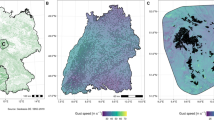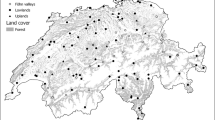Abstract
Data on storm damage attributed to the two high-impact winter storms ‘Wiebke’ (28 February 1990) and ‘Lothar’ (26 December 1999) were used for GIS-based estimation and mapping (in a 50 × 50 m resolution grid) of the winter storm damage probability (PDAM) for the forests of the German federal state of Baden-Wuerttemberg (Southwest Germany). The PDAM-calculation was based on weights of evidence (WofE) methodology. A combination of information on forest type, geology, soil type, soil moisture regime, and topographic exposure, as well as maximum gust wind speed field was used to compute PDAM across the entire study area. Given the condition that maximum gust wind speed during the two storm events exceeded 35 m s-1, the highest PDAM values computed were primarily where coniferous forest grows in severely exposed areas on temporarily moist soils on bunter sandstone formations. Such areas are found mainly in the mountainous ranges of the northern Black Forest, the eastern Forest of Odes, in the Virngrund area, and in the southwestern Alpine Foothills.





Similar content being viewed by others
References
Adrian G, Fiedler F (1991) Simulation of unstationary wind and temperature fields over complex terrain and comparison with observations. Beitr Phys Atmos 64:27–48
Agterberg FP, Bonham-Carter GF, Cheng Q, Wright D (1993) Weights of evidence modeling and weighted logistic regression for mineral potential mapping. In: Davis JC, Herzfeld UC (eds) Computers in geology—25 years of progress. Oxford University Press, New York, pp 13–32
Albrecht A (2009) Sturmschadensanalysen langfristiger waldwachstumskundlicher Versuchsflächendaten in Baden-Württemberg. Schriftenreihe Freiburger Forstliche Forschung, No. 42
Baker SG, Kramer BS (2007) Peirce, Youden, and receiver operating characteristic curves. Am Stat 61:343–346
Bonham-Carter GF (1994) Geographic information systems for geoscientists: modeling with GIS. Pergamon, Oxford
Bonham-Carter GF, Agterberg FP, Wright DF (1989) Weights of evidence modeling: a new approach to mapping mineral potential. In: Agterberg FP, Bonham-Carter GF(eds) Statistical Applications in the Earth Sciences. Geological Survey of Canada Paper 89-9, pp 171–183
Chung CF, Fabbri AG (1999) Probabilistic prediction models for landslide hazard mapping. Photogramm Eng Remote Sensing 65:1388–1399
Cremer KW, Borough CJ, McKinnel FH, Carter PR (1982) Effects of stocking and thinning on wind damage in plantations. N Z J For Sci 12:244–268
Daneshfar B, Desrochers A, Budkewitsch P (2006) Mineral-potential mapping for MVT deposits with limited data sets using Landsat data and geological evidence in the Borden Basin, Northern Baffin Island, Nunavut, Canada. Nat Resour Res 15:129–149
de Langre E (2008) Effects of wind on plants. Annu Rev Fluid Mech 40:141–168
Dilts TE, Sibold JS, Biondi F (2009) A weights-of-evidence model for mapping the probability of fire occurrence in Lincoln County, Nevada. Ann Assoc Am Geogr 99:1–15
Dobbertin M (2002) Influence of stand structure and site factors on wind damage comparing the storms Vivian and Lothar. For Snow Landsc Res 77:187–205
Donat MG, Leckebusch GC, Pinto JG, Ulbrich U (2010a) Examination of wind storms over Central Europe with respect to circulation weather types and NAO phases. Int J Climatol 30:1289–1300
Donat MG, Leckebusch GC, Pinto JG, Ulbrich U (2010b) European storminess and associated circulation weather types: future changes deduced from a multi-model ensemble of GCM simulations. Clim Res 42:27–43
Gardiner BA (1995) The interactions of wind and tree movement in forest canopies. In: Coutts MP, Grace J (eds) Wind and trees. Cambridge Univ Press, Cambridge, pp 41–59
Gardiner B, Byrne K, Hale S, Kamimura K, Mitchell SJ, Peltola H, Ruel J-C (2008) A review of mechanistic modelling of wind damage risk to forests. Forestry 81:447–463
Hanewinkel M, Zhou W, Schill C (2004) A neural network approach to identify forest stands susceptible to wind damage. For Ecol Manage 196:227–243
Hartebrodt C (2004) The impact of storm damage on small-scale forest enterprises in the southwest of Germany. Small Scale For Econ Manage Policy 3:203–222
Heneka P, Hofherr T, Ruck B, Kottmeier C (2006) Winter storm risk of residential structures—model development and application to the German state of Baden-Württemberg. Nat Hazard Earth Syst Sci 6:721–733
Hurrell JW, Kushnir Y, Visbeck M (2001) The North Atlantic Oscillation. Science 291:603–605
Jalkanen A, Mattila U (2000) Logistic regression model for wind and snow damage in northern Finland based on the National Forest Inventory data. For Ecol Manage 135:315–330
Kändler G, Bösch B, Schmidt M (2005) Wesentliche Ergebnisse der zweiten Bundeswaldinventur in Baden-Württemberg—Rückblick und Ausblick. Forstarchiv 60:45–49
Keil M, Kiefl R, Strunz G (2005) CORINE Land Cover 2000—Germany. Final Report, Wessling
Kohnle U, Gauckler S, Risse FJ, Stahl S (2003) Orkan Lothar im Spiegel von Betriebsinventur und Einschlagsbuchführung: Auswirkungen auf einen Forstbezirk im Randbereich des Sturms. Allg Forstz Wald 58:1203–1207
Kraus H, Ebel U (2003) Risiko Wetter. Die Entstehung von Stürmen und anderen atmosphärischen Gefahren. Springer, Berlin
Lohmander P, Helles F (1987) Windthrow probability as a function of stand characteristics and shelter. Scand J For Res 2:227–238
Masetti M, Poli S, Sterlacchini S (2007) The use of weights-of-evidence modelling technique to estimate the vulnerability of groundwater to Nitrate contamination. Nat Resour Res 16:109–119
Mayer H (1987) Wind-induced tree sways. Trees 1:195–206
Mayer H (1989) Windthrow. Phil Trans R Soc Lond B 324:267–281
Mayer P, Brang P, Dobbertin M, Hallenbarter D, Renaud J-P, Walthert L, Zimmermann S (2005) Forest storm damage is more frequent on acidic soils. Ann For Sci 62:303–311
Mitchell SJ, Hailemariam T, Kulis Y (2001) Empirical modeling of cutblock edge windthrow risk on Vancouver Island, Canada, using stand level information. For Ecol Manage 154:117–130
Mitchell SJ, Lanquaye-Opoku N, Modzelewski H, Shen Y, Stull R, Jackson P, Murphy B, Ruel J-C (2008) Comparison of wind speeds obtained using numerical weather prediction models and topographic exposure indices for predicting windthrow in mountainous terrain. For Ecol Manage 254:193–204
MLR (ed) (1994) Dokumentation der Sturmschäden 1990. Schriftenreihe Landesforstverwaltung Baden-Württemberg, No. 75, pp 9–61
Peltola H (1996) Swaying of trees in response to wind and thinning in a stand of Scots pine. Boundary Layer Meteorol 77:285–304
Pfister C (1999) Wetternachhersage. 500 Jahre Klimavariationen und Naturkatastrophen. Haupt, Bern, pp 246–255
Quine C, Gardiner B (2007) Understanding how the interaction of wind and trees results in windthrow, stem breakage, and canopy gap formation. In: Johnson EA, Miyanishi K (eds) Plant disturbance ecology—the process and the response. Elsevier, Amsterdam, pp 103–155
Quine CP, White IMS (1998) The potential of distance-limited topex in the prediction of site windiness. Forestry 71:325–332
Raines GL, Bonham-Carter GF, Kemp L (2000) Predictive probabilistic modelling using ArcView GIS. http://www.esri.com/news/arcuser/0400/files/wofe.pdf
Rauthe M, Kunz M, Kottmeier C (2010) Changes in wind gust extremes over Central Europe derived from a small ensemble of high resolution regional climate models. Meteorol Z 19:299–312
Romero-Calcerrada R, Luque S (2006) Habitat quality assessment using weights of evidence based GIS modelling: The case of Picoides tridactylus as species indicator of the biodiversity value of the Finnish forest. Ecol Model 196:62–76
Romero-Calcerrada R, Novello CJ, Millington JDA, Gomez-Jimenez I (2008) GIS analysis of spatial patterns of human-caused wildfire ignition in the SW of Madrid (Central Spain). Landscape Ecol 23:341–354
Rudnicki M, Silins U, Lieffers VJ, Josi G (2001) Measure of simultaneous tree sways and estimation of crown interactions among a group of trees. Trees 15:83–90
Sawatzky DL, Raines GL, Bonham-Carter GF, Looney CG (2008) Spatial Data Modeller (SDM): ArcMAP 9.2 geoprocessing tools for spatial data modelling using weights of evidence, logistic regression, fuzzy logic and neural networks. http://www.arcscripts.esri.com/details.asp?dbid=15341
Schelhaas M-J, Nabuurs G-J, Schuck A (2003) Natural disturbances in the European forests in the 19th and 20th centuries. Glob Chang Biol 9:1620–1633
Schindler D (2008) Responses of Scots pine trees to dynamic wind loading. Agric For Meteorol 148:1733–1742
Schindler D, Grebhan K, Albrecht A, Schönborn J (2009) Modelling the wind damage probability in forests in Southwestern Germany for the 1999 winter storm ‘Lothar’. Int J Biometeorol 53:543–554
Schindler D, Vogt R, Fugmann H, Rodriguez M, Schönborn J, Mayer H (2010) Vibration behavior of plantation-grown Scots pine trees in response to wind excitation. Agric For Meteorol 150:984–993
Scott RE, Mitchell SJ (2005) Empirical modelling of windthrow risk in partially harvested stands using tree, neighbourhood, and stand attributes. For Ecol Manage 218:193–209
Sellier D, Brunet Y, Fourcaud T (2008) A numerical model of tree aerodynamic response to a turbulent airflow. Forestry 81:279–297
Sinton DS, Jones JA, Ohmann JL, Swanson FJ (2000) Windthrow disturbance, forest composition, and structure in the Bull Run Basin, Oregon. Ecology 81:2539–2556
Uppala SM, Kållberg PW, Simmons AJ, Andrae U, Da Costa BV, Fiorino M, Gibson JK, Haseler J, Hernandez A, Kelly GA, Li X, Onogi K, Saarinen S, Sokka N, Allan RP, Andersson E, Arpe K, Balmaseda MA, Beljaars ACM, Van De Berg L, Bidlot J, Bormann N, Caires S, Chevallier F, Dethof A, Dragosavac M, Fisher M, Fuentes M, Hagemann S, Hólm E, Hoskins BJ, Isaksen L, Janssen PAEM, Jenne R, McNally AP, Mahfouf J-F, Morcrette J-J, Rayner NA, Saunders RW, Simon P, Sterl A, Trenberth KE, Untch A, Vasiljevic D, Viterbo P, Woollen J (2005) The ERA-40 re-analysis. Q J R Meteorol Soc 131:2961–3012
Valinger E, Lundquist L, Bondesson L (1993) Assessing the risk of snow and wind damage from tree physical characteristics. Forestry 66:249–260
von Teuffel K (2001) Waldbauliche Erfahrungen mit der Bewältigung der Sturmschäden von 1990 in Baden-Württemberg. In: J Huss, M Hehn (eds) Wiederbewaldung von Sturmschadensflächen. Ber Freiburg Forstl Forsch, No. 25, pp 79–87
Wang XL, Zwiers FW, Swail VR, Feng Y (2009) Trends and variability of storminess in the Northeast Atlantic region, 1874–2007. Clim Dyn 33:1179–1195
Acknowledgment
This study was carried out under the joint project RESTER (‘Strategies for the reduction of the storm damage risk for forests’) within the research program ‘Challenge Climate Change’, which was funded by the State Ministry of Environment of Baden-Wuerttemberg.
Author information
Authors and Affiliations
Corresponding author
Rights and permissions
About this article
Cite this article
Schindler, D., Grebhan, K., Albrecht, A. et al. GIS-based estimation of the winter storm damage probability in forests: a case study from Baden-Wuerttemberg (Southwest Germany). Int J Biometeorol 56, 57–69 (2012). https://doi.org/10.1007/s00484-010-0397-y
Received:
Revised:
Accepted:
Published:
Issue Date:
DOI: https://doi.org/10.1007/s00484-010-0397-y




